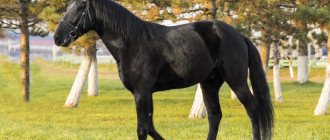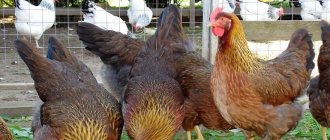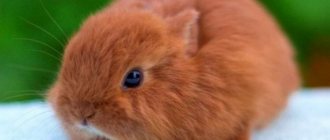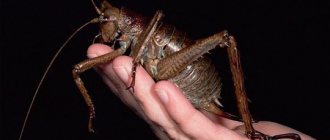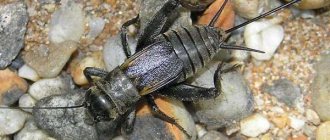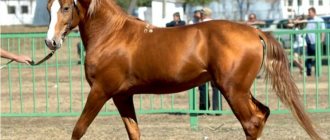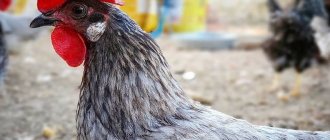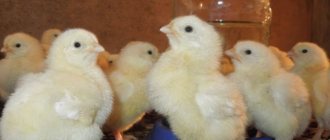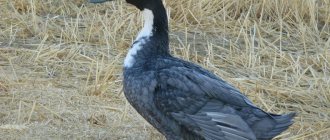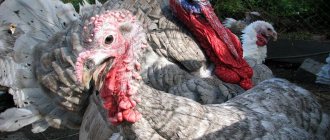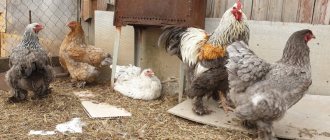Domesticated by North American Indians, the turkey came to Europe in the 16th century, and almost immediately the breeding of various hybrids of this valuable bird began, which was raised as a source of meat.
However, compared to the varieties of chickens, ducks and geese, the number of “breeding products” of these birds is small - there are about thirty of them, and the results of the work of domestic poultry scientists are seven. In total, there are 13 of them at poultry farms, on farms and individual farmsteads.
Turkey breeds received their names either by color or by designation of specificity (so-called “crosses” are distinguished, that is, hybrids with improved performance).
All breeding subspecies are divided into large “target sectors”:
- meat;
- egg;
- egg and meat.
They are also classified according to “weight categories” (the criterion is the weight of an adult). Breeds can be distinguished:
- light (up to 9 kg);
- medium (up to 18 kg);
- heavy (over 25 kg).
This article provides descriptions of the turkey breeds most commonly grown in our country. Also, the text information is supplemented with photographs that give an idea of the appearance of each of them.
Cross big 6
This “branch,” obtained in 2008 by specialists from the English company British United Turkeys in collaboration with Canadian biologists, is characterized by accelerated rates of maturation and approaching the stated weight mark.
So, after 3-4 months (that is, in one hundred days), this figure usually reaches 40 kg (that is, exceeds the threshold value for “heavyweights”). This is a broiler breed of turkeys used for meat.
They stand out for their snow-white lush plumage (by the way, you can get a lot of fluff from them, weightless and soft) with a “mark” on the chest - a bunch of dark gray hard feathers, large wings and a small head with earrings and a beard of a rich scarlet color. They belong to the broad-breasted turkey breeds.
Since the “output” from them is 80% of the pure product, and the “youth” and grown-up livestock are little susceptible to diseases, representatives of this line are the leaders in popularity in homesteads and peasant farmsteads. The egg production of hens is 105 for the entire time.
Blue
The blue turkey breed has another name - “slate”. This is a rare breed for our country. It can only be found in nurseries and isolated private farmsteads. The breed is considered decorative for most poultry farms, because even adult males barely reach 5 kg in weight.
An attractive side of the Blue breed is the unusual coloring of the birds, which can range from a soft blue tint (standard) to dark gray (culling). Interspersed with other colors indicate a non-purebred origin. Many blue breed breeders note increased sensitivity and sickness in birds.
Abroad, turkeys are bred not for meat, but as a pet, like parrots. Blue turkeys bond quickly with people and have a playful nature.
Cross Butte 8
This subspecies is also the result of the activities of British United Turkeys. Belonging to the medium-heavy and heavy divisions, in five months chickens gain 25-27 kg (for males) and about 10-11 kg (for turkeys).
Among other broilers, “Cross Butte 8” stands out for its purity of color without “marks”, red growths around the beak, and neat outlines of the body.
This subtype has not become widespread in Russia.
Best for home breeding
On private farms, poultry farmers raise turkeys mainly for meat, since the birds grow quickly and have high meat productivity. Based on these considerations, the most cost-effective are crosses, among which Big-6 stands out. The birds are characterized by high productivity, have a lot of weight, and females produce a sufficient amount of high-quality egg products. In addition, turkeys consume a small amount of feed, which is also very profitable. Other crosses are slightly behind this breed: Chiton and But-8, although they differ from other varieties in efficiency.
These breeds are good because with little input of feed and in a relatively short period of time, you can get quite a large amount of good quality meat. To have crosses, you need at least minimal experience in poultry farming, since the breeds require the creation of certain conditions and care. Based on this, breeding crosses is not suitable for everyone. The best option for beginners and those who do not want to spend a lot of time providing the necessary conditions would be local bird breeds. They weigh less, grow longer, but are easy to care for. In the summer, birds are quite capable of feeding themselves on a free range. Suitable for home breeding:
- Hybrid Converter is a Canadian hybrid, very popular due to its high meat yield, endurance and quick adaptation to different conditions;
- white Moscow - remarkably suitable for growing in backyards;
- Uzbek fawn - does not have too high productivity, but is extremely undemanding: the birds themselves obtain food for themselves and their offspring;
- North Caucasian birds are unpretentious, grow well, and are not picky about food;
- Tikhoretskaya black - characterized by low demands and free-range keeping, which significantly saves the amount of feed.
Cross station wagon
These broilers, optimally adapted for keeping in the private sector, were bred by breeders from the Russian Caucasus. Young and adult livestock are characterized by unpretentiousness and low feed consumption.
Laying hens are characterized by the ability to lay about 60-70 eggs per year. Almost all of them hatch into viable chicks.
Cross-universal – middle-weight broilers of the egg direction. By the end of the cycle, males and females reach 17 kg and 11 kg, respectively, for each sex.
- Raising turkeys - care, maintenance, feeding and profitability of turkey farms (130 photos)
Treatment of turkeys - signs and diagnosis of the most common diseases of young and adult turkeys (95 photos)
Turkey breeds - the most popular and best breeds for breeding in the home (115 photos)
Feeding
The diet is very important for this bird, no matter what conditions are created in the turkey poultry. Households do not always have the opportunity to use specialized combined feeds. And in this case, another advantage of the white broad-chested breed is revealed. It is capable of gaining significant weight on grain mixtures, unlike varieties intended exclusively for poultry farms. They give good results only on a combined feed.
To guarantee success, you need to establish nutrition from the first days of life. Until the end of the second or third week, turkey poults are given only balanced feed. It is not necessary to start feed in its pure form - a combination of it with prestart is also suitable. Only over time, when the turkeys’ bodies become stronger, can the birds be systematically transferred to independently selected grain mixtures.
The optimal diet for white broad-breasted turkeys contains the most corn, wheat and barley grains (30, 20 and 15%, respectively). Another 5.4% of food should be wheat bran. The fifth place in the diet is shared by peas, alfalfa flour and sunflower meal - 5% each. Turkeys will also need:
- 4% yeast;
- 3% chalk or shell rock;
- the same amount of bone meal;
- 2% fish and meat and bone meal;
- 0.5% table salt.
Complexes of vitamins and minerals are added to the basic diet. They must contain a certain amount of essential fats and amino acids. As for the use of antibiotics, this decision is made individually on all farms. It is best to follow the instructions of your veterinarian. To improve the taste of meat, succulent feed is used.
Along with freshly cut grass, these also include vegetables
They are given in two forms: fresh, mashed and boiled; Vegetable food is placed in feeders before noon, because it is important to control the consequences of its use. Since white broad-breasted turkeys are bred mainly for meat, the feed should contain a lot of proteins
But breeding birds are fed well, but strictly in moderation.
There are a few more recommendations:
- small chicks should be fed at least 8 times a day;
- Adults are usually given food 3 times a day;
- when active reproduction occurs, birds are transferred to 5 meals a day;
- clean, fresh water should be available to turkeys at all times and indefinitely.
Moscow bronze
Bred in Russian breeding grounds, it attracts owners of private farms and poultry farms with good survival results and accelerated growth, adapting well to being both on range and in cages.
“Moscow Bronzes” are used for meat when they reach 5 months, growing to the standard average weight group - 19 kg and 11 kg for turkeys and turkey hens, respectively. The productivity of each unit is 2 eggs per day, a total of 80-90 eggs.
Among other breeds, this one is distinguished by its unusual color - a mixture of rich brown and light shades with a pearlescent tint. However, brownish skin and feather stumps impair the commercial quality of the finished product.
conclusions
When breeding any poultry, you want to get a good result, because a lot of energy and money are invested in buying and raising it. Many poultry farmers have switched to raising turkeys. Because they are able to gain a lot of mass in a very short time. In addition, turkeys have good egg production and are also good and caring mothers. There are a little more than 30 breeds and crosses, so there is plenty to choose from:
- Meat giant crosses. Representatives of broiler breeds are white broad-breasted, Canadian broad-breasted broiler, BIG 6 cross and some others.
- Undemanding in terms of feeding and maintenance. Tikhoretsk black, Kuban, French and other breeds.
- Good hens. White Moscow, bronze broad-chested, chiton and others.
- In any case, by choosing the option you need, by the end of the breeding season you can get a lot of dietary meat and eggs for reproducing replacement young stock.
The pros and cons of raising turkeys as a business, read this link.
Hybrid converter
They are of industrial importance and widely distributed both in Russia and abroad. They go through their full life cycle on poultry farms that supply raw materials to meat processing complexes. Canadian breeding centers managed to breed them.
The period for them to gain the bulk of their mass (on average 22 kg for males and 12 kg for females) is five months. They are included in poultry production because the total carcass volume accounts for 80-85% of the muscle mass.
Characteristics and properties
Wild Turkey
The ancestors of domestic turkeys, living in the wild, love space and freedom. This property is also inherent in poultry. This means that for their comfortable existence they need pasture.
Domestic turkeys are characterized by the following features:
- Unlike their wild ancestors, domestic animals are calmer and slower.
- They are distinguished by strongly pronounced sexual dimorphism. This means that within one species there is a strong anatomical difference between male and female. For turkeys it is:
- size - males are larger than females;
- weight - a male individual is almost twice as heavy as a female (can reach 35 kilograms);
- skin - males have a leathery crimson-colored appendage hanging loosely from the beak;
- spurs - males have them, but females do not.
- They have strong, strong legs, allowing them to reach running speeds of up to V = 50 km/h. They easily cover a distance of one and a half kilometers. The calf muscles of the strong legs of turkeys contain a lot of zinc, which is necessary for strengthening bones and tendons. Therefore, their meat serves as a source of this important trace element for humans.
- Unlike chickens, turkeys do not rake the ground with their paws, so they do not destroy crops. They are only looking for suitable food there. These can be various midges and insects, including those harmful to crops, for example, the Colorado potato beetle. In the homeland of the wild ancestors of domestic turkeys - in North America - they are a threat to these harmful beetles.
- They are farsighted. Because of this, it is difficult to see small objects at close range. Therefore, spilled food is not noticed and is simply found by accident. While chickens peck the grain instantly. This feature creates the erroneous opinion that turkeys are stupid. Therefore, the food from the feeder should not spill.
- They tolerate cold more easily than heat. This is due to their large mass. In hot weather they drink a lot of water. The goiter fills with water. Bacteria develop there. This causes the intestines to become inflamed. The bird may die.
- Sexual and behavioral characteristics:
- The turkey is a flocking bird. But packs are formed by gender. In flocks it is easier to care for the young and escape from enemies.
- Starting from the third day of life of the chicks, turkeys take them out for walks to learn how to get food. Three-month-old male turkey chicks are already undergoing the “young fighter course,” that is, their mothers, arranging funny fights with them, introduce them to the traditions of the male flock.
- Eight-month-old males leave the maternal flock and create their own male flock. There begins a fierce struggle for supremacy. Often the result is the death of one of the participants in the fight. The bird that wins all becomes the leader. She also has the right to inseminate turkeys. Everyone else plays the role of extras.
- Domestic turkeys are also grouped by gender, starting from two to three months of age. Otherwise, they experience psychological discomfort. In addition, due to different rates of weight gain, the nutrition of males and females will be different. And it is easier to separate feed when kept separately.
- A turkey becomes sexually mature at eight months.
- Lays eggs for six months. During this period, it lays from seventy to one hundred eggs.
- A turkey needs just one sexual act to lay fertilized eggs for a long time.
- Before slaughter, the turkey is kept for four months. Her weight by this time reaches approximately ten kilograms.
- Male turkeys go to slaughter at six months.
Bronze broad-breasted
It was obtained in America as a selective cross between black English and wild “branches”. So called due to the powerful development of the thoracic region. However, in general, the final figures are small - 15-16 kg and 10 kg for males and females.
“Bronze Broad-breasted” is distinguished by its original plumage color – dark, shimmering green. The tail feathers are striped, brown-beige, edged with dark. Chickens have light spots on their breasts.
This line refers to the “egg” direction. The total number of eggs laid by turkeys can be 120. Their fertility rate is very high, and the laying hens themselves have a strong maternal instinct - they hatch their own and other people's offspring equally successfully.
Treatment of turkey poults - symptoms, prevention, main diseases and features of caring for and raising turkey poultsKeeping turkeys: care, breeding, breeds, conditions and profitability of a turkey farm (115 photos)
- Feeding turkey poults: feeding rates and times, optimal diet and mixture composition depending on age (110 photos)
Basic characteristics of birds of different breeds
The turkey breed is diverse; the most popular classification is dividing them into three directions: egg, meat and universal.
Bronze turkeys will decorate any farmstead
Egg production breeds
This direction is not among the popular ones, since the birds do not have good egg production, and obtaining eggs ultimately turns out to be unprofitable. However, some breeds show good results:
- Virginia;
- cross Big 9;
- cross Hidon;
- bronze.
The Virginia or Dutch breed of turkeys are small birds whose weight does not exceed 10 kg. In six months, the most productive females can lay up to 60 eggs. Cross Big-9 has a fairly large mass and productivity of up to 120 eggs annually. The bronze turkey allows you to get up to 100 eggs annually. The Hidon cross is considered the most capricious: despite the fact that these birds eat the least amount of food, they are very difficult to breed.
Note! Chicks may die due to humidity, drafts, and temperature changes.
Representatives of the Hidon cross
Breeds of meat and egg productivity
These breeds of turkeys are meat breeds, but they also allow you to get eggs as a by-product. These varieties include: Uzbek fawn, North Caucasian bronze, Universal cross. The latter is the pride of domestic selection; it was officially registered in 2003. Advantages of the breed:
- weight from 10-20 kg;
- egg production - up to 70-80 eggs annually;
- ease of care;
- rapid rate of weight gain.
North Caucasian Bronze is a turkey bred in the Caucasus in the second half of the 20th century. These are very large birds of increased endurance.
Representatives of the Uzbek fawn breed have modest performance, but are capable of gaining weight very well, which is why they are often found on private farmsteads.
Meat (broiler) direction
Turkey breeds of this type of productivity are characterized by a high rate of weight gain, which is why they are raised for meat. These are the largest birds of the entire turkey family, their breeding is available both in central Russia, and in Siberia, and in the Far East, the main thing is to choose the right breed. The following are considered the most productive broilers:
- cross Big 6;
- white broad-chested;
- Grade Maker;
- Moscow bronze;
- hybrid converter.
All these breeds are distinguished by significant weight and a good rate of weight gain. The average for a 6 month old bird is 26-29 kg. The Moscow Bronze is considered the best breed for raising in Russia - it is an unpretentious bird with good meat performance.
Note! This breed can be bred both in cages and on open range.
Artificially bred turkey crosses have good meat productivity and attractive appearance
Bronze North Caucasian
The credit for developing this “line” belongs to the breeders of the Stavropol Territory. For a long time, the main breeding area for such turkeys was the Central Asian republics. They are still in demand due to their rapid growth and weight gain, survival rate and undemanding diet.
After the first month, grown chickens weigh 4 kg, growing to 12-15 kg and 8-9 kg (for males and females) by slaughter age. The carcasses are rich in white meat (25% of this muscle is in the thoracic region).
The appearance of this species is specific - with an elongated, long-legged body with a massive chest. The appearance of the “roosters” is very impressive, thanks to the combination of black and brown feathers with a golden-bronze tint and a fan-shaped tail. The feathers of the “hens” are less striking and pockmarked.
There is good adaptation of young animals to pasture rearing. Egg production is not very high and amounts to about 40-50 clutches for the entire period. Young animals are not intended for slaughter, since due to the purple color of their skin they are not marketable.
Largest turkey: Canadian
Everyone knows that turkeys are the largest poultry. But among them there are record holders for weight. This is, for example, a Canadian turkey. It belongs to the broiler type and is the result of the work of Canadian breeders. This poultry has a unique and characteristic exterior:
The Canadian breed quickly gains weight.
After three months it reaches slaughter weight. Long and massive legs;- The chin is in the form of a fleshy appendage;
- The plumage is black or white. May have a bronze tint;
- The body is dense, elongated. The chest is powerful, fleshy;
- They are unpretentious in food and by one and a half months of life they can already weigh about 5 kilograms;
- Marketable weight is gained by three months;
- They begin to lay eggs at nine months;
- The percentage of eggs hatching is very high.
Fattening this cross is profitable until the age of 90 days, then the bird goes to slaughter.
Characteristics: how much does it weigh
Main productivity indicators of Canadian turkeys:
| Indicators | Units | Productivity |
| Turkey live weight | kg | up to 30 |
| Turkey live weight | kg | until 17 |
| Egg production | things | about 100 |
| Egg weight | gram | from 70 to 80 |
| Laying period | months | from 9 to 15 |
| Egg hatchability | % | 93 |
Fawn
This meat and egg subcategory was the result of long work by Uzbek poultry farmers. It is zoned, that is, adapted to a hot climate. It is bred in the Caucasian and Central Asian countries.
This breed got its name due to its reddish coloring, with fawn and beige “variations”. The main feature is slow growth and slow achievement of the “killer” criterion (12 kg and 6-7 kg for the “strong” and “weaker” sex).
The most suitable method of care for such birds is to let them roam freely. From such turkeys they produce up to 30 clutches (1-2 eggs per day) per season.
Summarizing this unique review, it is worth saying that you can decide which breed of turkeys is better, not only by familiarizing yourself with the specifics of each of the listed ones, but also by taking into account the characteristics of the premises and territories intended for the cultivation and breeding of these domestic birds, as well as other factors .
Features of choice
Before you go shopping for eggs or chicks, we study the breeds of turkeys with descriptions and photos attached to them.
When looking at photos of turkey breeds, pay attention to the size of the chest. The larger it is, the greater the meat yield after slaughter. When cutting a carcass, the sternum does not contain waste. Therefore, among all new breeds of turkeys, the lion's share is made up of broad-chested birds.
It is not worth buying chicks at the market. If there is a turkey farm nearby, then go there to buy it. There you can not only look at a catalog of turkey breeds with descriptions and photos, but also consult a specialist. He will tell you how to choose a turkey breed depending on the climatic characteristics of a particular region, your capabilities and needs.
Don't try to get the best varieties. Many of them require large areas for grazing. Limit yourself to those breeds that do not need a large area for walking and that are not demanding in care. After all, sometimes it is more expedient to buy not hummers, but ordinary mopeds, which, for example, are better for the village. Same with turkeys. keeping giant breeds is justified if we are talking about breeding birds on an industrial scale.
Photos of turkeys
Where to buy
When purchasing any turkey or turkey, spare no time or money in choosing the farm where you will purchase your bird. In many ways, the health of the turkey and the quality of the meat subsequently depend on this.
Variety of feed
The main quality of nutrition is balance. It must include all the necessary nutrients for development. If the birds do not have free range, you need to provide them with all the vitamins and microelements. The feed should include:
- proteins - products containing protein of plant or animal origin (fish and meat waste, cake, legumes)
- carbohydrates – grain crops (millet, barley, oats, corn) and root vegetables (potatoes, beets, carrots)
- vitamins (pumpkin and silage, nettle, birch, conifer hay) minerals (chalk, shells, fishmeal)
- dairy products (cottage cheese, skim milk, yogurt)
- fine gravel to improve digestion
- vegetable oil, lard for juiciness of meat

